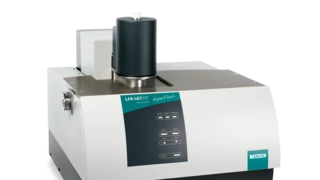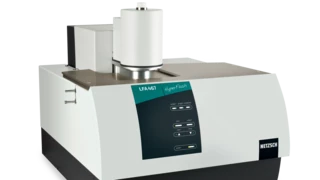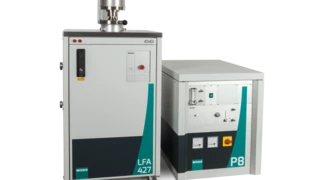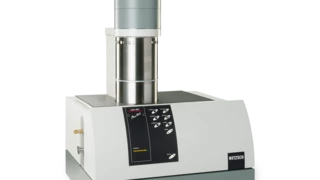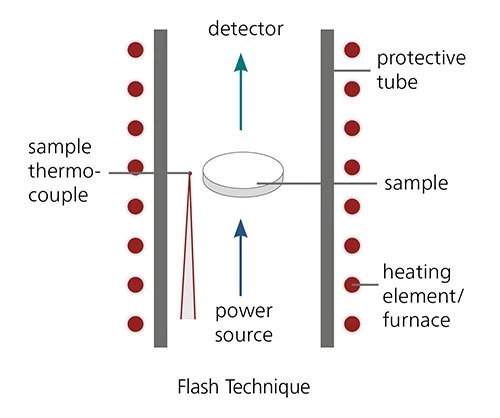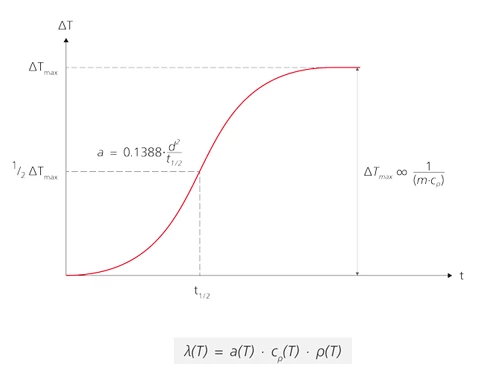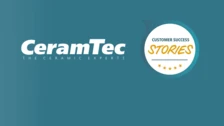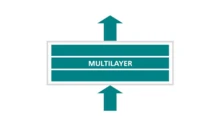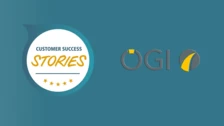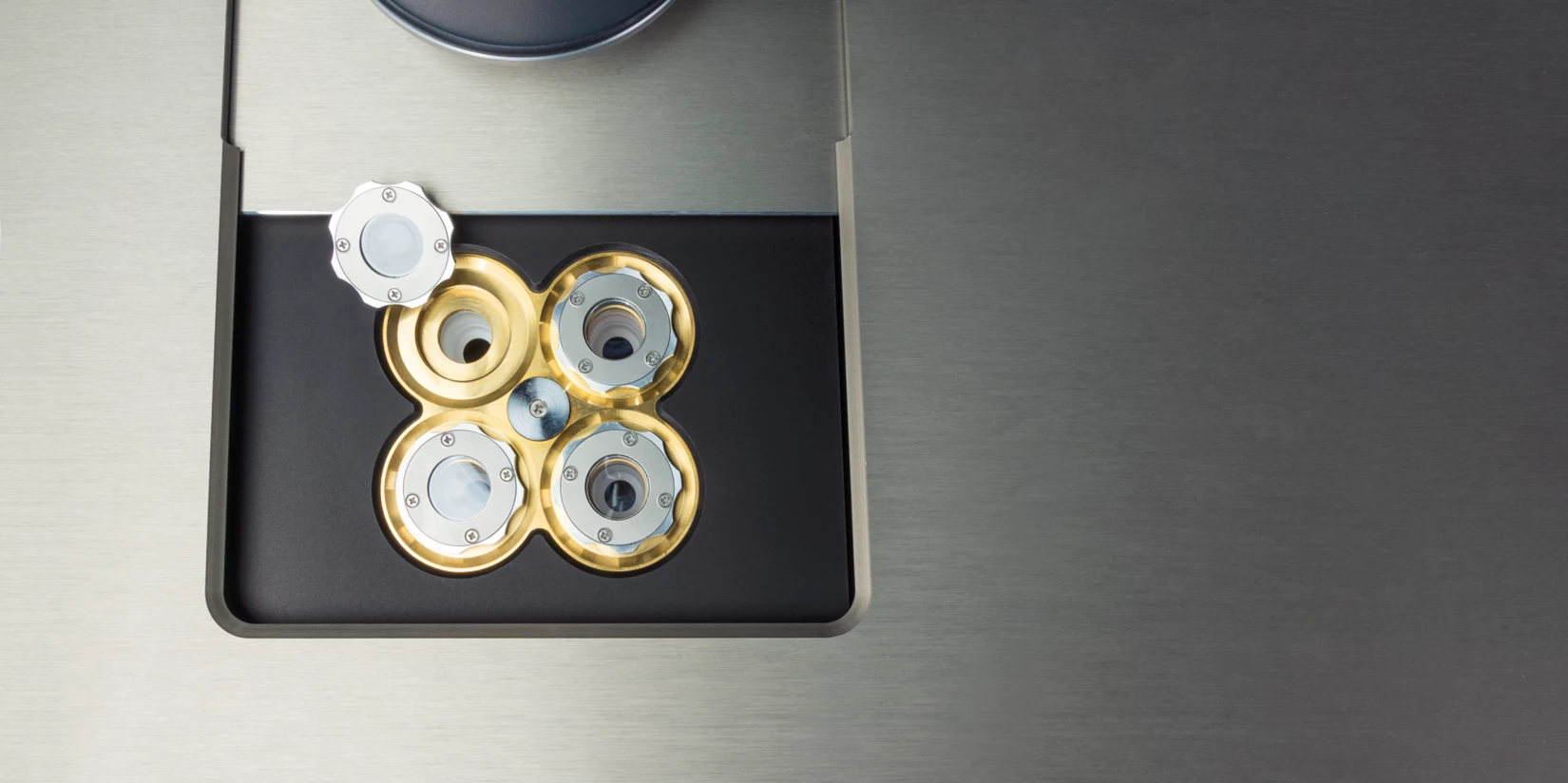
LFA
Light/Laser Flash Analyzer
for measuring the Thermal DiffusivityThermal diffusivity (a with the unit mm2/s) is a material-specific property for characterizing unsteady heat conduction. This value describes how quickly a material reacts to a change in temperature.Thermal Diffusivity and Thermal ConductivityThermal conductivity (λ with the unit W/(m•K)) describes the transport of energy – in the form of heat – through a body of mass as the result of a temperature gradient (see fig. 1). According to the second law of thermodynamics, heat always flows in the direction of the lower temperature.Thermal Conductivity
For the precise measurement of thermophysical properties like the Thermal DiffusivityThermal diffusivity (a with the unit mm2/s) is a material-specific property for characterizing unsteady heat conduction. This value describes how quickly a material reacts to a change in temperature.thermal diffusivity, the Laser Flash technique (LFA) has proven itself as a fast, versatile and precise absolute method. NETZSCH offers four LFA models, covering the entire spectrum of materials and temperatures.
NETZSCH instruments are based on the respective instrument and application standards for LFA (e.g., ASTM E1461, DIN EN 821-2, DIN 30905, ISO 18755, ISO 22007-4, BS EN 1159-2, ASTM C714, etc.).
Principle of the LFA Method
The laser or light flash method is used for measurement of the Thermal DiffusivityThermal diffusivity (a with the unit mm2/s) is a material-specific property for characterizing unsteady heat conduction. This value describes how quickly a material reacts to a change in temperature.thermal diffusivity of a variety of different materials.
The front surface of a plane-parallel sample is heated by a light pulse and the resulting temperature rise at the sample’s rear face is recorded as a function of time. The higher the Thermal DiffusivityThermal diffusivity (a with the unit mm2/s) is a material-specific property for characterizing unsteady heat conduction. This value describes how quickly a material reacts to a change in temperature.thermal diffusivity, the faster the temperature rise reaches the rear face.
In a one-dimensional, the Thermal DiffusivityThermal diffusivity (a with the unit mm2/s) is a material-specific property for characterizing unsteady heat conduction. This value describes how quickly a material reacts to a change in temperature.thermal diffusivity rise is calculated from this temperature rise as follows:
a = 0.1388 ⋅ d² / t0.5 with
a – Thermal DiffusivityThermal diffusivity (a with the unit mm2/s) is a material-specific property for characterizing unsteady heat conduction. This value describes how quickly a material reacts to a change in temperature.Thermal diffusivity in cm²/s
d – Thickness of the sample in cm
t0.5 – Time to half minimum in s
With all NETZSCH laser flash apparatuses (LFAs), the Thermal DiffusivityThermal diffusivity (a with the unit mm2/s) is a material-specific property for characterizing unsteady heat conduction. This value describes how quickly a material reacts to a change in temperature.thermal diffusivity and Specific Heat Capacity (cp)Heat capacity is a material-specific physical quantity, determined by the amount of heat supplied to specimen, divided by the resulting temperature increase. The specific heat capacity is related to a unit mass of the specimen.specific heat capacity can be determined. This data is then used for calculation of the Thermal ConductivityThermal conductivity (λ with the unit W/(m•K)) describes the transport of energy – in the form of heat – through a body of mass as the result of a temperature gradient (see fig. 1). According to the second law of thermodynamics, heat always flows in the direction of the lower temperature.thermal conductivity.
Determination of Thermal Diffusivity and Thermal Conductivity
For the precise measurement of thermal diffusivity a or conductivity (λ), the flash method has established itself as a rapid, versatile and precise measuring method. NETZSCH offers a total of four models (LFA 467 HyperFlash®, LFA 457 MicroFlash®, LFA 467 HyperFlash® HT and LFA 427), which cover the total a broad spectrum of materials and temperature ranges.
The Thermal ConductivityThermal conductivity (λ with the unit W/(m•K)) describes the transport of energy – in the form of heat – through a body of mass as the result of a temperature gradient (see fig. 1). According to the second law of thermodynamics, heat always flows in the direction of the lower temperature.thermal conductivity (λ) of insulation materials can be determined directly with plate instrumentation (HFM = Heat Flow Meter or GHP = Guarded Hot Plate): Included here are the HFM 446 Lambda with its new, expanded measurement capabilities and the GHP 456 Titan® guarded hot plate, which is an absolute method and thus requires no calibration.
The instruments listed above operate in accordance with relevant instrument and usage norms. Specifically, these include:
- For LFA: ASTM E1461, DIN EN 821-2, ISO 22007-4, ISO 18755
- For HFM: ASTM C518, ISO 8301, DIN EN 12667, JIS A 1412
- For GHP: ISO 8302, ASTM C177, DIN EN 12939, DIN EN 12667, DIN EN 13163
For the measurement of particularly thin films we offer the PicoTR/NanoTR Time Domain Reflectance method.
Application Literature

MEASUREMENT WANTED?
Our NETZSCH applications laboratory is providing contract testing services for a wide range of industries and research centers. It is equipped with state-of-the-art testing instruments allowing for a variety of thermal analysis measurements to be carried out.
Consult with the experts in our applications labs to choose the best-suited measuring method for your specific needs.
